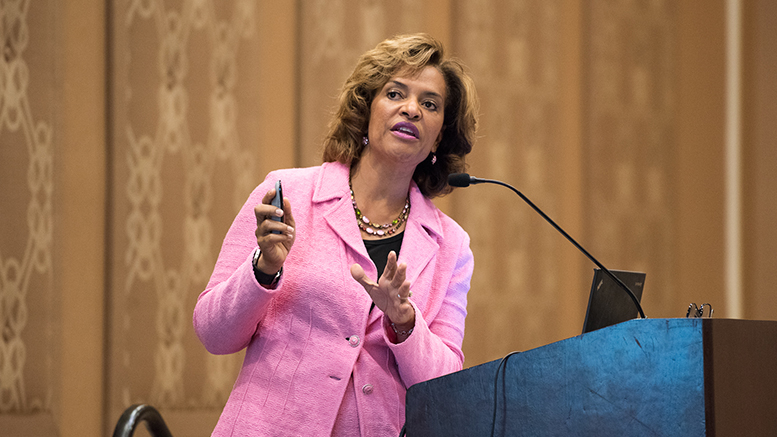DALLAS — “Our colleges are not in crisis. We’re in motion.”
That’s the positive spin Sandra Kurtinis, president of the Community College of Baltimore County (CCBC), put on the declining enrollment trend during a discussion about enrollment at the annual convention of the American Association of Community Colleges.
“For those of us who’ve been around for a while, we’re all troopers,” said Kurtinitis, who also serves as AACC board chair-elect of AACC. “We’ve all seen enrollments go up and down. It’s like the stock market.”
“If you take a strategic approach, you will weather this storm,” she said.
Troubling trends
Enrollment at CCBC dropped from 72,000 in 2010 to 62,000 in 2016, a loss Kurtinitis attributes to several factors:
- The nation’s “astonishingly healthy economy” and historically low unemployment rate
- Reduced funding for federal financial aid programs and stricter standards for applicants
- Too many students stuck in the developmental education continuum
- A national climate that has devalued the benefits of a college education
Federal IPEDS data show that community college enrollment spiked along with the unemployment rate during the recession 10 years ago, said Kent Phillippe, associate vice president for research and student success at AACC. Over the last six years, however, enrollment has been declining at a consistent rate, he said.
Among other trends cited by Phillippe:
- Enrollment of full-time students is declining at a faster rate than part-time students.
- Enrollment of white students is declining, while that of other demographic groups is rising.
- Hispanic enrollment has seen the greatest gains, which are due, in part, to IPEDS adding a “more than one race” category in 2008.
- The percent of white students enrolling for the first time in a community college is declining.
- The percentage of community college students younger than 18 is up significantly, most likely due to the increase in dual enrollment.
- Community college students ages 18-21 is the only group where there are more full-time than part-time students, but the number of full-time students in this group is significantly declining – and that is cause for concern.
- The number of high school graduates is increasing, but a growing number of them are enrolling in four-year institutions.
Targeted recruiting
At Palm Beach State College (PBSC), President Ava Parker made enrollment growth a campus-wide priority.
That’s critical because state funding has gone down, so the college must rely on tuition to meet its financial obligations. Raising enrollment by just 1 percent brings in $500,000, Parker said.
Recruiting more students “became everybody’s responsibility,” she said, not just the provenance of the student affairs department.
That required a change in culture, as PBSC adopted a series of strategies beginning in 2015. Those efforts paid off, as the college has had a 6.6 enrollment increase since then, while the rest of Florida’s higher education system has continued to see declines.
Recruiting efforts targeted specific high schools, along with and the more than 4,600 students who started an application to PBSC but failed to follow through.
PBSC used institutional aid to help students get into and stay in college.
For example, the Finish4Free program provides scholarships to close the gap for dual-enrollment students with at least 30 credits to earn a degree. The college also provided loans to students who applied for financial aid but haven’t received it yet.
PBSC stepped up its services to potential students by outsourcing phone calls and financial aid verification during peak periods. The college borrowed that idea from for-profits, Parker said, noting that customer service is one thing for-profits do right.
The college also uses social media to stay in close contact with students in the admissions pipeline. “We want to ensure students are committed to us. We let them know we want them,” she said. And it set a standard of processing all applications within 48 hours.
The college contacts “stop-outs” and offers them financial incentives to come back, including waiving the tuition for a course if they have a GPA of 2.0 or higher.
Future strategies for growth, Parker said, include targeting recruiting to special populations, recruiting more international students, and getting universities to guarantee admission to online programs from students who earned an associate degree online.
“I am determined we will not have enrollment controlled by the economy,” Parker said.
Big changes
Kurtinitis said her strategy was to “accept the fact of declining enrollment and focus on retooling and rightsizing.” That is being accomplished through technology, transformational academics and creative partnerships.
One thing Kurtinitis refused to do is lay off or furlough staff. “If people feel mistreated or not valued, they will not do what needs to be done,” she said.
Every piece of marketing that CCBC puts out stresses the college’s low cost – annual tuition and fees are just $3,868.
“We’re not growing but have at least stopped the bleeding,” she said.
“We’ve gotten the whole college around the idea that what you do matters in terms of getting students in the door, keeping them and getting them to completion,” Kurtinitis said.

